Introduction
Because of the diversity of accounting systems and in response to the globalization of the economy and markets, international accounting harmonization emerges, with the primary objective of contributing to the standardization of practices, transparency, and comparability of financial information reported by entities from different jurisdictions (Lopes & Camões, 2021).
In this sense, the International Accounting Standards Committee (IASC) and, after its extinction, the International Accounting Standards Board (IASB) developed a set of standards, namely the International Accounting Standards (IAS) and International Financial Reporting Standards (IFRS), respectively, which aim to minimise accounting differences and contribute to improving the quality and comparability of financial information disclosed on a global scale (O Cualain & Tawiah, 2023). In the European Union (EU), Regulation (EC) No 1606/2002 of the European Parliament and of the Council of 19 July 2002 was responsible for the introduction of these standards, whether mandatory or optional, depending on certain requirements. That Regulation thus determined that entities with securities admitted to trading on any regulated market in the EU should now mandatorily adopt in their consolidated accounts, on a mandatory basis, the IAS and IFRS issued by the IASB, as endorsed by the EU (hereinafter simply referred to as IFRS in this context). In addition, it established that each Member State should determine the optional or mandatory use of such standards to prepare the so-called annual accounts of such entities.
In addition to the purpose of providing useful information for users’ decision-making (Al-Refiay et al., 2022), financial information must be comparable, transparent, and understandable (Tarca, 2020). However, even with the adoption of IFRS, the comparability of financial information is not fully ensured, due to, among others, existing options for the recognition, measurement, and disclosure of various accounting matters, referred to in the international literature as accounting choices (Olante & Lassini, 2022).
Due to the flexibility underlying the IFRS, the IASB has been developing projects to standardize them in an attempt to bridge the existence of different treatments for the same subject (Souza et al., 2015). However, this problem is still present in several IFRS, namely in the IAS 27 – Separate Financial Statements (SFS), the focus of this study, as adopted by the Commission Regulation (EU) No. 2023/1803, of 13 August 2023. Under this standard, financial investments in subsidiaries, associates, and joint ventures (hereinafter simply referred to as interests) can be accounted for by the cost method, by the Equity Method (EM), or even under IFRS 9 – Financial Instruments, which translates into the option for fair value through profit or loss (FVPL) or other comprehensive income (FVOCI). Consequently, and due to the alternatives available in IFRS, entities are faced with the need to make accounting choices.
Considering the different options available to entities when preparing their SFS, this exploratory paper aims to identify the accounting methods (cost method, EM, FVPL or FVOCI) used for those interests (subsidiaries, associates, and joint ventures) under IAS 27 by listed European entities. The subject matter of the investigation comprises the SFS for the year 2021 and the method of accounting for those interests in these accounts. The study sample covers the entities listed in the main capital markets’ indices of the stock exchanges of EU countries that use IFRS to prepare their SFS and also provide these accounts, whether mandatory or optional. In the light of the literature review, no studies were identified that used as their object the accounting of those interests within the SFS, despite the profusion of studies on accounting choices in different areas. In this regard, only one investigation concerning equity investments in general was identified (Catuogno & Allini, 2011).
The matter of interest in other entities is a key audit matter usually highlighted in auditors’ reports, thus assuming itself as a relevant research topic in this area (Neukirchen & Bonotto, 2017). The relevance of the study is further reinforced by the fact that the interests held by the parent company of the groups listed on EU stock exchanges represent 51.5% of the Gross Domestic Product recorded in the same territory in 2018 (The World Bank, n.d.). However, because these are non-mandatory accounts in some jurisdictions, in the specific case of entities that already submit their consolidated accounts, there is a greater gap in the literature on matters related to SFS. However, the financial information reported in these accounts may prove to be necessary and useful (Busari & Bagudo, 2021). In addition, the objectives proposed in this study
are justified by the different impacts on the financial position and performance of entities, from the accounting choices provided for in IAS 27 for the accounting of interests in other entities, potentially affecting comparability and relevance, which is consequently reflected in the context of the users’ decision-making from financial information.
This study is structured in three sections, in addition to this introduction. The next section provides the materials and methods used for the proposed exploratory analysis. The results obtained are presented in the third section. Finally, the fourth section presents the conclusions, as well as the limitations and suggestions for future investigations.
Materials and Methods
The present exploratory study resorts, primarily, to the method of archive research and documental analysis as a technique. The data were extracted from the entities’ SFS within this sample research. The empirical field corresponds to the entities included in the main indices of stock exchanges from EU countries where IFRS adoption in SFS is mandatory or optional.
Those indices were mostly identified from the website investing.com. In turn, the entities that comprise those indices were collected from the LSEG Eikon database, having the ending of January of 2023 as the reference, except for the entities from FTSE MIB and MSE, which were extracted from the Amadeus database and the stock exchange annual report for 2022, respectively. Then, the information regarding the IFRS adoption in SFS as mandatory or optional was gathered from the IFRS Foundation website. More specifically, this information was gathered from the countries’ positive answers to the question “are IFRS Accounting Standards required or permitted in separate company financial statements of companies whose securities trade in a public market?” available in the document “jurisdiction profile”. Following, only the entities from indices/countries that might use IFRS, mandatorily or optionally, were identified as the target for this research (initial sample).
Finally, all SFS found for the year ending in 2021 through each entity’s website in the sample were collected, except those for which the reporting date differs significantly from the calendar year, i.e. where the reporting period mostly covers the year 2020. In such circumstances, the SFS for 2022 were used (six cases). In addition, in those cases for which the SFS for 2021 were not available at the time of data collection, the SFS for 2020 were exceptionally used (three cases). From this process, seventy-two entities that do not provide their respective reports and accounts were excluded, as well as ten that are silent on the accounting method adopted for such investments. Due to the availability of their reports in a language other than Portuguese or English and incompatible formats for automatic translation, six entities were excluded from the scope of this research.
Table 1 shows the indexes in which the European listed entities from the sample are included, also providing details as to whether it is mandatory or optional to apply the IFRS in their SFS. In certain cases, the type of adoption depends on specific criteria and, consequently, both types of adoption by country were found. Those cases are explained in the column observation.
Table 1: Sample Description
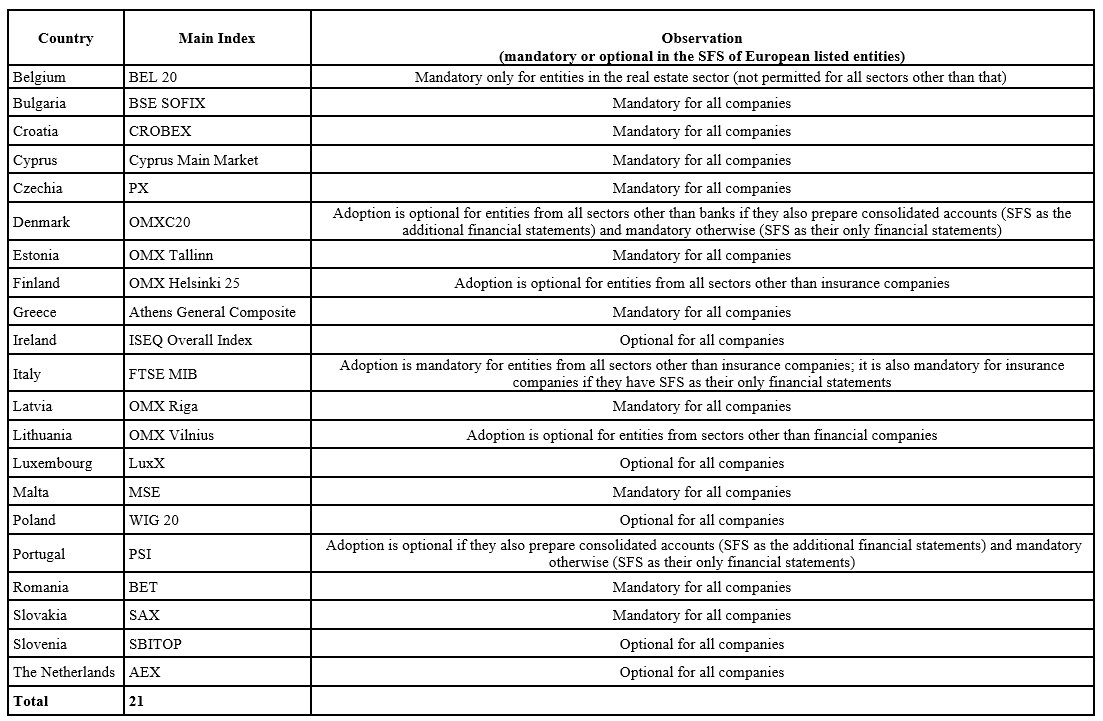
Source: Own elaboration
Table 2 summarizes the number of excluded entities from the initial to the final sample.
Table 2: Sample Selection
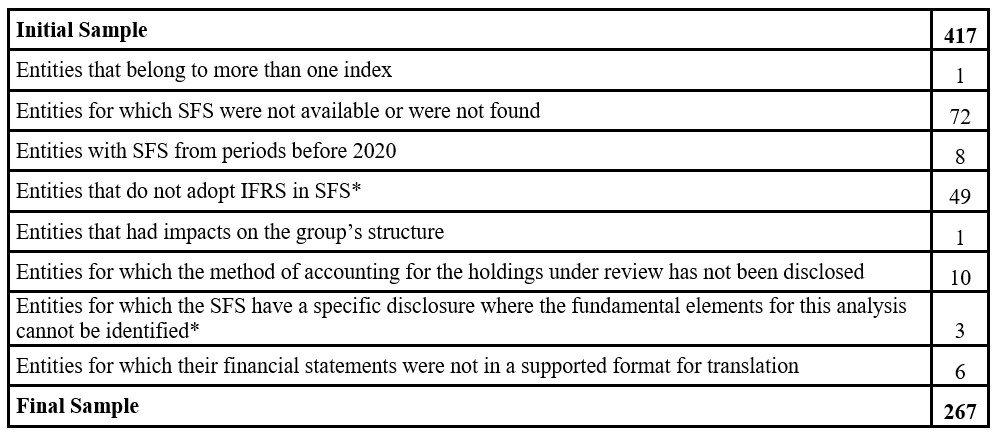
Note: * At the end of this process, all the 3 entities from Belgium and the 24 from Finland were excluded, as none of them met the criteria selected for analysis, namely they do not disclose fundamental data and have used other standards, respectively.
Source: Own elaboration
Thus, at the end of the selection process, 267 entities met the criteria defined for analysis and were distributed among the indices of the capital markets representing different countries, as shown in Table 3. After excluding all entities from Belgium and Finland, which do not meet the criteria for analysis, the final research sample is comprised of 19 countries.
Table 3: Distribution of entities by country
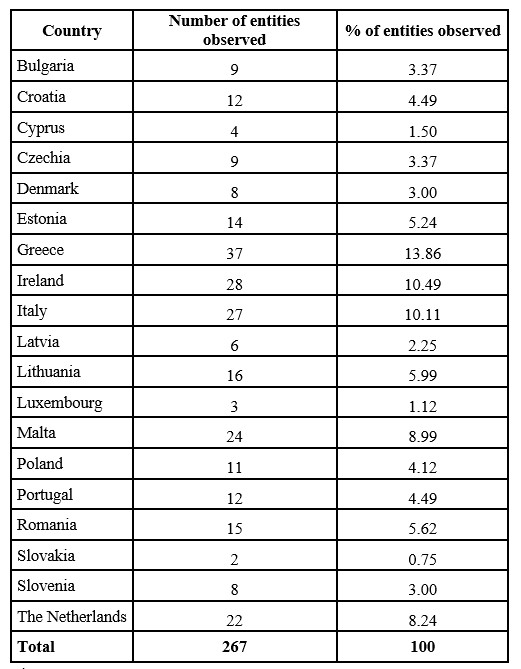 Source: Own elaboration
Source: Own elaboration
The economic activity sector was identified based on the classification of the Industry Classification Benchmark (ICB), and six sectors were identified for the entities under analysis in this study, namely:
- Industrials
- Consumer goods
- Energy & Utilities
- Financial & Insurance
- Healthcare
- Telecommunications & Technology
The following section is dedicated to the presentation of the results obtained, based on the methodological lines previously detailed. The results will be presented with breakdowns by country and sector.
Results
This section presents the results obtained concerning the accounting choices used by the European entities within their SFS for the interests in the scope of IAS 27.
Table 4 provides the frequencies for those cases by country.
Table 4: Accounting methods, by country and total (in number and percentage)

Source: Own elaboration
Table 4 shows a reduced level of dispersion for the accounting methods used by the entities for the interests under assessment in their SFS. Overall, the cost method is used in 80% of the cases. Following, 13% of entities use the EM, which is also the main method used by entities in The Netherlands, as an exception (with 82%). Entities from Romania, Ireland, Lithuania, and Luxembourg are those for which the FVPL is also identified. Most European countries use the cost method as the main one for accounting for their interests within the SFS (higher than two-thirds of entities from these countries), with 4 out of 19 using this method exclusively. As previously indicated, the only exception in this context is The Netherlands, for which only 18% of entities (4 out of 18) use this method for this purpose. Finally, for a single entity from Greece and Malta, the FVOCI is exclusively used.
Considering the relevance of this matter, Table 5 identifies the accounting methods used by entities specifically for subsidiaries in their SFS, by country.
Table 5: Accounting methods for subsidiaries, by sector and total (in number and percentage)
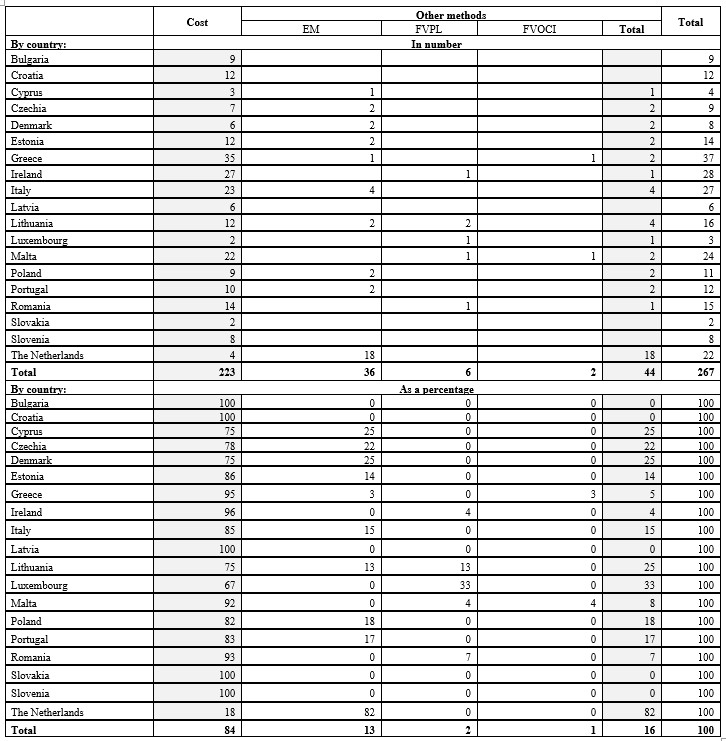
Source: Own elaboration
Table 5 shows no relevant differences regarding the method chosen by European entities for specifically accounting for the subsidiaries in their SFS, in comparison to the previous analysis made for all interests under IAS 27 from Table 4. The single case that can be stressed is the entities from Slovenia, for which the cost method increased from 75% to 100%.
Following, Table 6 provides the same figures by the economic activity sector.
Table 6: Accounting methods, by sector and total (in number and percentage)
 Source: Own elaboration
Source: Own elaboration
Table 6 shows that the choice of methods other than cost does not exceed 30% across sectors. Entities from the telecommunications and technology sector and entities in the financial and insurance sector are those which frequently selected methods other than cost, with 29% and 25%, respectively. The financial and insurance sector also stands out as the one with the greatest diversity of methods chosen, although it does not include entities that exclusively select the FVOCI, which is only observed for a single entity from the industrials and consumer goods sectors. It is also for the entities from the financial and insurance sector that the FVPL is of greater interest. Despite the low use of other methods, in all economic activity sectors, the use of both the cost method and the EM can be found.
Finally, Table 7 identifies the accounting methods used by entities specifically for subsidiaries, by economic activity sector.
Table 7: Accounting methods for subsidiaries, by sector and total (in number and percentage)
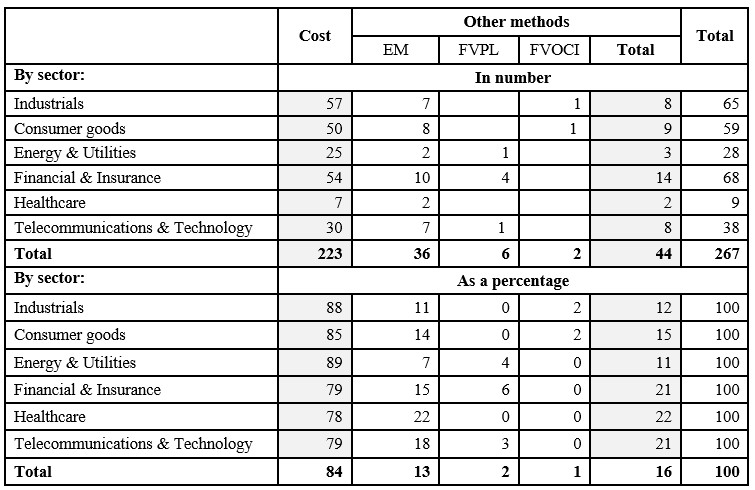 Source: Own elaboration
Source: Own elaboration
Similarly to what can be seen in the previous analysis, Table 7 shows the reduced variability of the methods adopted also in the context of accounting for subsidiaries, with only 16% of the entities using methods other than cost in such cases. In other words, the cost method takes on even greater relevance with regard specifically to the accounting option identified for subsidiaries, with emphasis on entities in the energy and utilities as well as telecommunications and technology. Only the industrial and healthcare sectors maintain the same relative importance of cost adoption when comparing the accounting choices for all interests under IAS 27 and the method specifically selected for subsidiaries.
The following section is dedicated to the presentation of conclusions, limitations, and perspectives for future lines of research within the scope of this study.
Conclusions
The empirical study proposed in this study, related to comparability within the SFS under IAS 27, assessed the accounting choices provided for in the standard for the accounting of interests in subsidiaries, associates, and joint ventures in the entities’ SFS. Notwithstanding the diversity of treatments provided for in this standard, the cost method was identified as the one predominantly used by the entities, especially concerning the accounting of subsidiaries. Differences by country and sector were also identified, with emphasis on the use of more diverse methods by entities in the financial and insurance sector and the preference for the EM by entities from The Netherlands.
As for the study’s limitations, it is important to highlight the difficulty in collecting all the information necessary to perform this study. More specifically, and for the analysis provided in this paper, the accounting method used is not easily identifiable and is subject to adequate identification by the researcher. Furthermore, it is limited to entities that publicly provide their SFS.
For future investigations, it is suggested to study the explanatory factors behind the accounting methods underlying IAS 27, either using the sample proposed in this research, by country and sector, or with a possible extension to other indices and industries. Those studies can resource different theories, namely disclosure theories, and explanatory factors, such as the entities’ financial-economic and corporate governance characteristics, as well as local and environmental influences, such as cultural, political, social, and legal influences, including the effects of local taxes. Further studies may also include the optional versus mandatory use of IAS 27 as an explanatory factor in this context.
Although exploratory, this paper presents contributions to the literature in the context of the problem of accounting choices, by identifying the methods of accounting the interests in the entities’ SFS, a matter not yet explored in the literature. It is intended that the conclusions obtained from the study of accounting choices are relevant for academics, standard-setter bodies, and investors, since they awaken a problem that mitigates comparability, a fundamental factor in decision-making, despite the ongoing work of reducing different optional accounting treatments (Souza et al., 2015). Finally, auditors, supervisors, and users of reporting in general will also benefit from this research, as it allows us to understand the motivations behind the use of the more strategic method of accounting for interests in other entities.
Acknowledgement
The authors extend sincere gratitude to the Instituto Politécnico de Lisboa IPL/IDI&CA2023/SepAccount_ISCAL for their valuable support.
References
- Al-Refiay, H., Abdulhussein, A. & Al-Shaikh, S. (2022). The impact of financial accounting in decision-making processes in business. International Journal of Professional Business Review, 7(4),1-13. https://doi.org/10.26668/businessreview/2022.v7i4.e627
- Busari, K. & Bagudo, M. (2021). Comparing the value relevance of selected accounting information in consolidated and separate financial statements: The case of Nigerian listed financial service firms. Journal of Economics and Sustainability, 3(2), 16-32. https://doi.org/10.32890/jes2021.3.2.2
- Catuogno, S. & Allini, A. (2011). Multiple evaluation options & comparability: Equity investments in Italy and Spain. Journal of Accounting and Management Information Systems 10(2), 249-274. https://www.researchgate.net/publication/227367930
- Commission Regulation (EU) 2023/1803 of 13 August 2023 adopting certain international accounting standards in accordance with Regulation (EC) No 1606/2002 of the European Parliament and of the Council. (2023). Official Journal of the European Union, L 237, 1 – 992. https://eur-lex.europa.eu/eli/reg/2023/1803
- (2022). Financial reporting developments- Equity method investments and joint ventures.https://assets.ey.com/content/dam/ey-sites/ey-com/en_us/topics/assurance/accountinglink/ey-frd02230-161us-06-28-2022.pdf?download
- Lopes, A. & Camões, R. (2021). Sobre o valor relevante das demonstrações financeiras separadas. º USP International Conference in Accounting. https://congressousp.fipecafi.org/anais/21UspInternational/ArtigosDownload/3142.pdf
- Neukirchen, L. & Bonotto, M. (2017). Análise dos principais assuntos de auditoria (PAA) divulgados pelas big four na primeira adoção do novo relatório do auditor de empresas listadas no nível “novo mercado” de governança corporativa na Bm&F Bovespa. https://lume.ufrgs.br/bitstream/handle/10183/182991/001073110.pdf?sequence=1&isAllowed
- Cualain, G. & Tawiah, V. (2023). Review of IFRS consequences in Europe: An enforcement perspective. Cogent Business & Management, 10(1), 1-19. https://doi.org/10.1080/23311975.2022.2148869
- Olante, M. & Lassini, U. (2022). Investment property: Fair Value or cost model? recent evidence from the application of IAS 40 in Europe. Advances in Accounting, 56, 1-16. https://doi.org/10.1016/j.adiac.2021.100568
- (2020). Initial measurement of equity method investment. [Website]. https://viewpoint.pwc.com/dt/us/en/pwc/accounting_guides/equity_method_of_accounting/Equity_Method_account/chapter_3/32_initial_measure.html
- Regulation (EC) No 1606/2002 of the European Parliament and of the Council of 19 July 2002 on the application of international accounting standards. Official Journal of the European Union, L 243, 1 – 4. https://eur-lex.europa.eu/legal-content/EN/TXT/?uri=CELEX%3A32002R1606&qid=1705246707795
- Souza, F., Botinha, R., Silva, P. & Lemes, S. (2015). A comparabilidade das escolhas contábeis na avaliação posterior de propriedades para investimento: Uma análise das companhias abertas brasileiras e portuguesas. Revista Contabilidade e Finanças, 26 (68), 154-166. https://doi.org/10.1590/1808-057×201500580
- Tarca, A. (2020). The IASB and comparability of international financial reporting: Research evidence and implications. Australian Accounting Review, 30(4), 231-242. https://doi.org/10.1111/auar.12326
- The World Bank. (n.d.). Market capitalization of listed domestic companies (% of GDP) – European Union. [Website]. https://data.worldbank.org/Indicator/CM.MKT.LCAP.GD.ZS?End=2018&locations=EU&start=1975&view=chart









